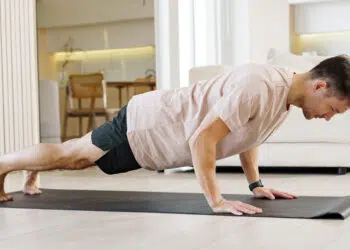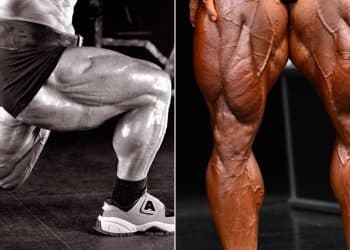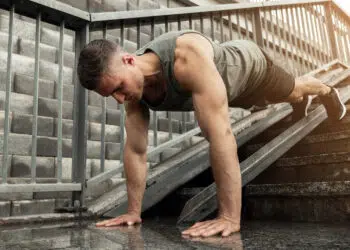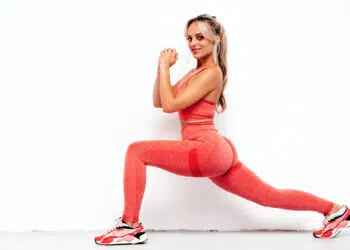Ask most people what the best back exercise is, and you’ll get a range of answers. Some will say pull-ups, others pulldowns and you already know the deadlift is a very popular option. A few may even mention bent-over rows and pullovers. But what if you are stuck at home and don’t have much workout equipment available? What’s the best back exercise then?
In our opinion, one of the best at-home back builders you can is the inverted row and, contrary to what a lot of people think, you don’t need any equipment to do this exercise.
Inverted row anatomy
We’re all agreed that the inverted row is a back exercise but, because it’s a compound move, it involves far more muscles than just your lats. The main muscles of focus in this exercise are:
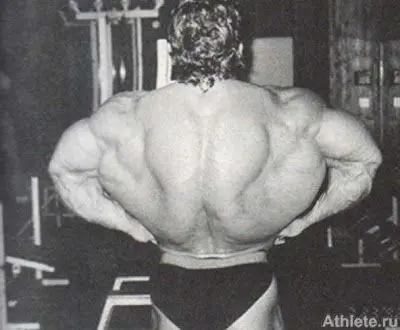
Latissimus dorsi – located on the side of your upper back, your lats extend and adduct your upper arm. When well developed, your lats look like wings and are visible from the front and rear.
Middle trapezius and rhomboids – these muscles are listed together because they always work together. The middle trapezius is located across your scapula or shoulder blades, while the rhomboids are between them. They pull your shoulder blades together in a movement called retraction.
Posterior deltoid – your rear shoulder muscles are involved in horizontal extension of your arm. They’re small but essential muscles that add a lot to how your back looks, and they play a crucial role in posture and shoulder joint health too.
Level Up Your Fitness: Join our 💪 strong community in Fitness Volt Newsletter. Get daily inspiration, expert-backed workouts, nutrition tips, the latest in strength sports, and the support you need to reach your goals. Subscribe for free!
Biceps brachii – more commonly known as your biceps, this muscle is responsible for flexion of your elbow. You can’t do inverted rows without getting a good biceps workout too.
Posterior chain – the collective name for the muscles on the back of your body, in inverted rows, the posterior chain works to hold your body straight and rigid. Muscles that make up the posterior chain include the erector spinae, glutes, and hamstrings.
How to do inverted rows at home
Before we reveal the different ways you can do inverted rows at home, let’s just revise the basic technique you need to use so you can enjoy all the benefits this exercise has to offer.
1 – Set a bar to about waist-height and then sit on the floor below it. Reach up and hold the bar using an overhand, slightly wider than shoulder-width grip. Straighten your legs and arms and lean back.
2 – Lift your hips off the floor, so your body is straight. Pull your shoulders down and back and brace your core. Your weight should be supported by your hands and heels only.
3 – Keeping your body tense and straight, bend your arms and pull your chest up to the bar. Extend your arms and repeat. Do not relax between reps; keep your body straight throughout.
Most gym-goers do inverted rows using a barbell in a squat rack or a Smith machine. Thankfully, there are some additional ways to do this back-builder so that home exercisers can do it too.
1 – TRX inverted rows
If you’ve got a suspension trainer like a TRX, you have everything you need to do inverted rows at home. In fact, because you can rotate your hands into a neutral or palms facing inward position, TRX inverted rows are often more comfortable and easier on your wrists and elbows than the straight bar version.
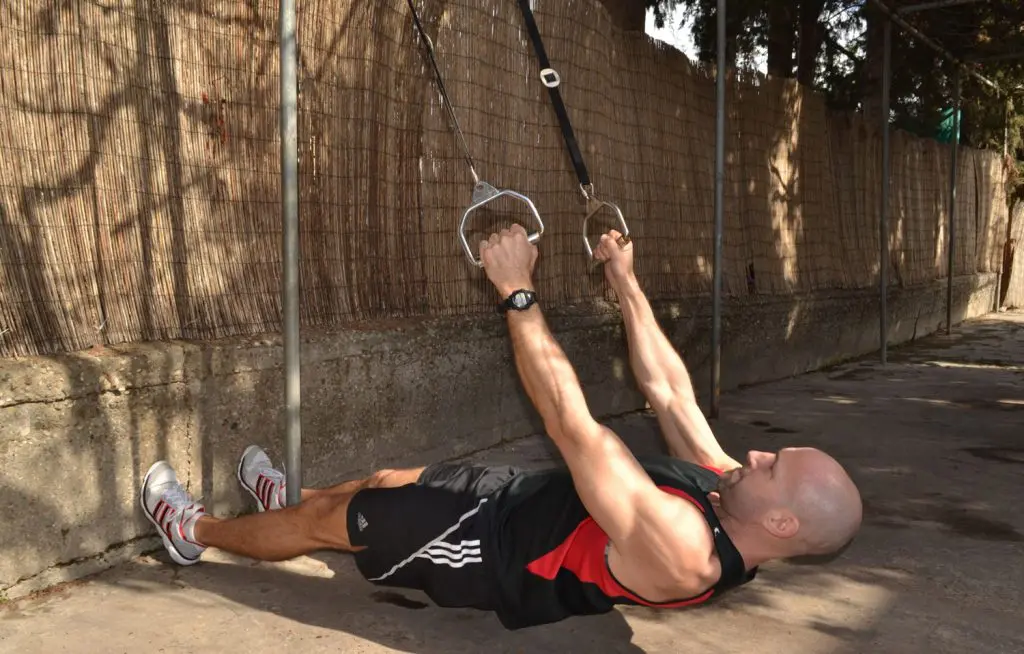
To do TRX inverted rows, fix your suspension trainer to a strong overhand anchor. Double-check the anchor because, if it fails, you could fall and land on your back. Once you are confident your anchor will hold, do your inverted rows as described above.
2 – Bed sheet inverted rows
No TRX? No problem! You can create a similar set-up so you can do inverted rows at home. Take two single-size bed sheets and tie a knot at the end of each one. Next, place the bedsheets over the top of a door, so the knots hang a little way down the back of the door. Close the door and pull the bedsheets until the knots slide up and stop at the doorframe.
Sit on the floor with your legs straight and reach up to grab a handful of bedsheet in each hand. Lift your hips and lean back, so your body and arms are straight, and your feet are against the bottom of the door. Bend your arms and pull your shoulders up to your hands. Extend your arms and repeat.
Make this exercise as safe as possible by warning anyone nearby that you are exercising and that they should not attempt to open the door during your workout.
3 – Table inverted rows
You can build your back at home using nothing more than a sturdy table. Sit on the floor beneath something like a heavy dining table and hold the edge with an overhand grip. Lean back, so your arms and legs are straight. Lift your hips off the floor. Bend your arms and pull your chest up to the underside of the table. Extend your arms and repeat.
If your table is suitable, you can also grip the sides and do neutral-grip inverted rows. Alternatively, place a strong broomstick on your table and grab an end in each hand. Protect the table by placing a folded mat or towel between it and the pole.
4 – Playground inverted rows
If you live near a playground or have play equipment in your yard or garden, you can also do inverted rows there. Just make sure that whatever you are using is strong enough to support your weight.

You could also use a tree branch if you can find one that’s the right height.
5 – Partner inverted rows
If you are completely stuck for somewhere to do inverted rows at home, you can do this exercise with a partner instead. However, it’s important to know that you will need a very capable helper to do this exercise as they’re going to have to support a lot of your weight with their arms, legs, and back.
To do this exercise, lie on the floor between your partner’s feet. Reach up and grip their wrists as they grip yours. Lean back, straighten your legs and then row yourself up as usual.
FAQs
Do you have any questions about doing inverted rows at home? We’ve got answers! If you can’t find the information you are looking for below, drop us a line in the comments section, and we’ll get back to you as soon as we can.
Can't I just do pull-ups instead?
Pull-ups and inverted rows work many of the same exercises, but, where pull-ups involve a vertical pulling action, inverted rows involve a horizontal one. This means the muscle and joint actions are different and, for building size and strength, different is often useful. Studies tell us that exercise variation is vital for maintaining progress (1), so it’s helpful to have more than one way to work your muscles. As good as pull-ups are, inverted rows are a useful addition to your workouts.
How can I make inverted rows harder?
The main disadvantage of exercises like inverted rows is that you are limited to your bodyweight for resistance. If you can do a lot of reps relatively easily, this exercise won’t be hard enough to build muscle or strength. Here are a few ways to make this exercise harder and more productive.
- Raise your feet– lifting your feet puts more weight on your arms. Place your feet on a knee-high chair or step.
- Add a mid-rep pause– pause for 2-3 seconds at the top of each rep. This will increase the duration of your set, and also helps eliminate momentum, both of which will make your workout harder.
- Rest a weight on your chest or hips– temporarily increase your body weight by placing a weight on your chest or hips. You’ll also need to brace your core harder to keep your body straight.
- Do one-arm inverted rows– while you will probably need to raise the bar to reduce the load on your arm, you can do this exercise unilaterally to make it harder. Try to do the same number of reps on each arm.
How can I make inverted rows easier?
There are two ways you can make this exercise easier.
- Bend your legs– bending your legs takes weight off your arms. This is the equivalent of doing push-ups on your knees. The closer your feet are to your hands, the easier this exercise becomes.
- Use a shallower angle – the more upright your body, the less demanding inverted rows will be. If you are using a TRX or the bedsheet method, move your grip up to raise your shoulders, and enjoy an easier workout.
Are bodyweight inverted rows as good for building muscle as things like bent-over rows?
Your body cannot differentiate between bodyweight exercises like inverted rows and barbell exercises like bent-over rows. After all, your muscles don’t have eyes and cannot see what you are doing! So long as you overload them with enough weight, your muscles will get bigger and stronger whatever you are lifting, be that a barbell, weight machine stack, or your own body. Still not convinced that bodyweight exercises are good for building muscle? Many gymnasts, fighters, and soldiers train exclusively using bodyweight exercises, and they are all built!
How should I work inverted rows into my workouts?
Ideally, you should do this exercise 1-2 times per week as part of your back or upper body workout. Adjust your set/rep scheme to match your goals. If you are training for muscle mass, do 6-12 reps per set. If you want to build strength, use sets of 1-5 reps. For endurance, sets of 13-20 work best. Choose the variation that takes you to muscular failure within the appropriate rep range.
Wrapping up
When it comes to bodyweight back exercises, most people tend to choose pull-ups. And while there is nothing wrong with this exercise, inverted rows can be just as useful, and may even be a better choice. After all, you can do inverted rows using nothing more than a table. The same cannot be said for pull-ups! Even if you CAN do pull-ups at home, including inverted rows in your workouts will add some much-needed variety, which will help you get bigger and stronger in much less time.
References:
1 – PubMed: Changes in exercises are more effective than in loading schemes to improve muscle strength https://www.ncbi.nlm.nih.gov/pubmed/24832974


